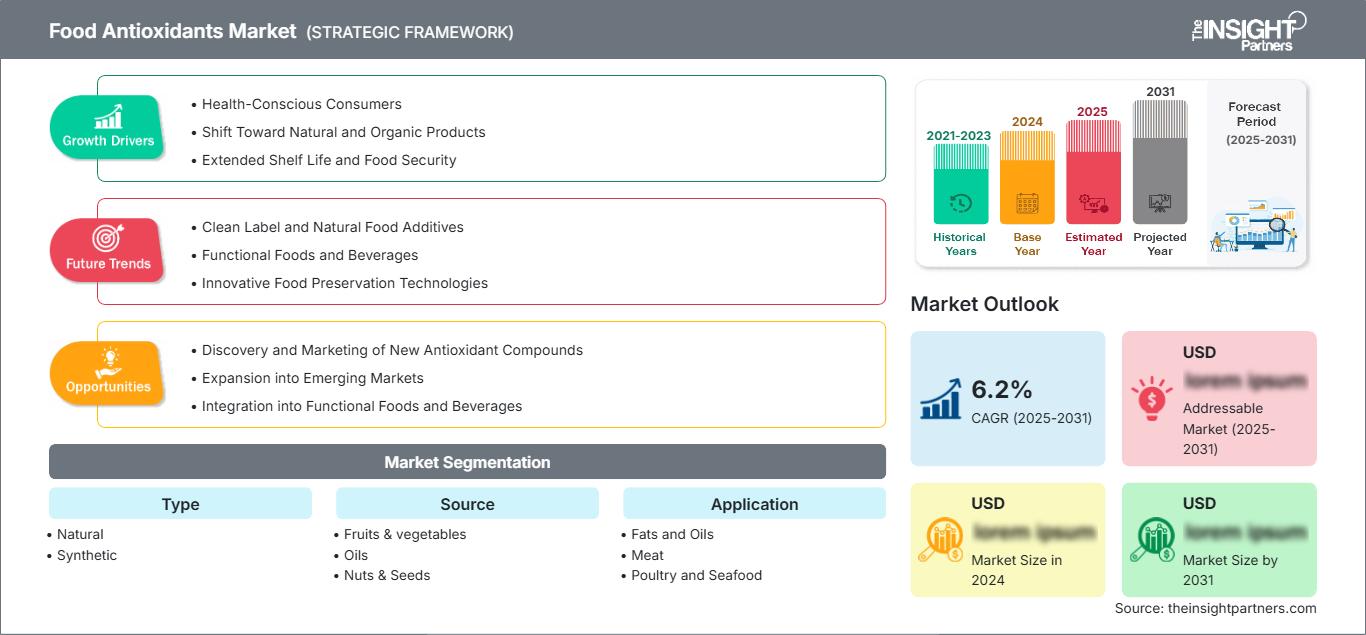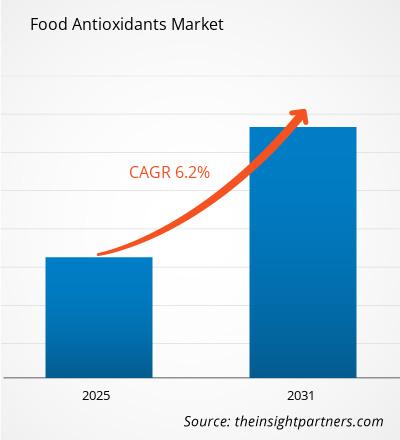The Food Antioxidants Market size is expected to reach US$ 2.23 Billion by 2031. The market is anticipated to register a CAGR of 6.2% during 2025-2031.
The Food Antioxidants Market Report is segmented by type into Natural and Synthetic. The source segment includes Fruits & Vegetables, Oils, Nuts & Seeds, Spices & Herbs. The application segment includes Fats and Oils, Meat, Poultry and Seafood, Bakery and Confectionery, and Beverages. The market evaluation is presented in US$ for the above segmental analysis. The global analysis is broken down at the regional level and major countries. The market evaluation is presented in US$ for the above segmental analysis.
Purpose of the Report
The report Food Antioxidants Market by The Insight Partners aims to describe the present landscape and future growth, top driving factors, challenges, and opportunities. This will provide insights to various business stakeholders, such as:
- Technology Providers/Manufacturers: To understand the evolving market dynamics and know the potential growth opportunities, enabling them to make informed strategic decisions.
- Investors: To conduct a comprehensive trend analysis regarding the market growth rate, market financial projections, and opportunities that exist across the value chain.
- Regulatory bodies: To regulate policies and police activities in the market with the aim of minimizing abuse, preserving investor trust and confidence, and upholding the integrity and stability of the market.
Food Antioxidants Market Segmentation Type
- Natural
- Synthetic
Source
- Fruits & vegetables
- Oils
- Nuts & Seeds
- Spices & herbs
Application
- Fats and Oils
- Meat
- Poultry and Seafood
- Bakery and Confectionery
- Beverages
Geography
- North America
- Europe
- Asia-Pacific
- South and Central America
- Middle East and Africa
You will get customization on any report - free of charge - including parts of this report, or country-level analysis, Excel Data pack, as well as avail great offers and discounts for start-ups & universities
Food Antioxidants Market: Strategic Insights

-
Get Top Key Market Trends of this report.This FREE sample will include data analysis, ranging from market trends to estimates and forecasts.
Food Antioxidants Market Growth Drivers
- Health-Conscious Consumers: Growing awareness of the health benefits of antioxidants, particularly their role in reducing oxidative stress and preventing chronic diseases, is driving consumers to seek healthier, antioxidant-rich food options.
- Shift Toward Natural and Organic Products: The rising demand for natural, organic food products, driven by concerns about the side effects of synthetic additives, is fueling the growth of the food antioxidants market, especially those derived from plant-based and naturally sourced ingredients.
- Extended Shelf Life and Food Security: Antioxidants are increasingly used to enhance the shelf life of food products by preventing oxidation, a major cause of spoilage. This helps reduce food waste and improve food security, driving demand for antioxidants in food preservation.
- Growth in Processed and Packaged Food: As the food and beverage industry, particularly in emerging economies, continues to grow, the need for antioxidants as essential food additives to maintain product quality and prolong shelf life is also rising.
Food Antioxidants Market Future Trends
- Clean Label and Natural Food Additives: The growing consumer preference for simple, recognizable ingredients is fueling the demand for natural, plant-based antioxidants. This shift is driving manufacturers to focus on clean-label products with no artificial additives or preservatives.
- Functional Foods and Beverages: The rising popularity of functional foods and beverages, which offer health benefits beyond basic nutrition, is boosting the demand for antioxidants. These products are fortified with bioactive compounds, including antioxidants, to improve overall health and well-being.
- Innovative Food Preservation Technologies: The development of antioxidant-based packaging and coatings is revolutionizing food preservation. These technologies help extend food shelf life and reduce food waste, increasing the demand for antioxidants in packaging solutions.
- Personalized Nutrition: As consumers become more aware of their specific nutritional needs, there is an increasing demand for customized food products. Tailored antioxidants in these products help address individual health concerns, driving innovation and growth in the food antioxidants market.
Food Antioxidants Market Opportunities
- Discovery and Marketing of New Antioxidant Compounds: The development of novel antioxidant molecules from unique natural sources presents a major opportunity for companies to differentiate themselves in the market. By offering innovative antioxidant compounds, businesses can create a strong value proposition and meet consumer demand for new, effective antioxidants.
- Expansion into Emerging Markets: As awareness of health and wellness grows in emerging markets, the demand for antioxidant-rich food products is rising. Companies can tap into these new markets to expand their customer base and boost market growth, capitalizing on the increasing focus on nutrition and wellness in these regions.
- Integration into Functional Foods and Beverages: The demand for functional foods and beverages is on the rise, and antioxidants can be combined with other functional ingredients like probiotics or omega-3 fatty acids to offer multiple health benefits. This integration creates opportunities for product innovation and increased consumer appeal.
- Sustainability and Ecological Production: Adopting sustainable and eco-friendly production practices for antioxidants can offer a competitive edge, as environmentally conscious consumers prefer products that are produced with minimal environmental impact. Reducing the carbon footprint through sustainable practices can enhance brand reputation and attract a larger customer base.
The regional trends and factors influencing the Food Antioxidants Market throughout the forecast period have been thoroughly explained by the analysts at The Insight Partners. This section also discusses Food Antioxidants Market segments and geography across North America, Europe, Asia Pacific, Middle East and Africa, and South and Central America.
Food Antioxidants Market Report Scope
| Report Attribute | Details |
|---|---|
| Market size in 2024 | US$ XX Million |
| Market Size by 2031 | US$ 2.23 Billion |
| Global CAGR (2025 - 2031) | 6.2% |
| Historical Data | 2021-2023 |
| Forecast period | 2025-2031 |
| Segments Covered |
By Type
|
| Regions and Countries Covered |
North America
|
| Market leaders and key company profiles |
|
Food Antioxidants Market Players Density: Understanding Its Impact on Business Dynamics
The Food Antioxidants Market is growing rapidly, driven by increasing end-user demand due to factors such as evolving consumer preferences, technological advancements, and greater awareness of the product's benefits. As demand rises, businesses are expanding their offerings, innovating to meet consumer needs, and capitalizing on emerging trends, which further fuels market growth.

- Get the Food Antioxidants Market top key players overview
Key Selling Points
- Comprehensive Coverage: The report comprehensively covers the analysis of products, services, types, and end users of the Food Antioxidants Market, providing a holistic landscape.
- Expert Analysis: The report is compiled based on the in-depth understanding of industry experts and analysts.
- Up-to-date Information: The report assures business relevance due to its coverage of recent information and data trends.
- Customization Options: This report can be customized to cater to specific client requirements and suit the business strategies aptly.
The research report on the Food Antioxidants Market can, therefore, help spearhead the trail of decoding and understanding the industry scenario and growth prospects. Although there can be a few valid concerns, the overall benefits of this report tend to outweigh the disadvantages.
Frequently Asked Questions
What are the deliverable formats of the Food Antioxidants Market report?
What are the options available for the customization of this report?Â
Which are the leading players operating in the Food Antioxidants Market?
What are the future trends of the Food Antioxidants Market?
What is the expected CAGR of the Food Antioxidants Market?
What are the driving factors impacting the Food Antioxidants Market?
- Historical Analysis (2 Years), Base Year, Forecast (7 Years) with CAGR
- PEST and SWOT Analysis
- Market Size Value / Volume - Global, Regional, Country
- Industry and Competitive Landscape
- Excel Dataset
Recent Reports
Related Reports
Testimonials
Reason to Buy
- Informed Decision-Making
- Understanding Market Dynamics
- Competitive Analysis
- Identifying Emerging Markets
- Customer Insights
- Market Forecasts
- Risk Mitigation
- Boosting Operational Efficiency
- Strategic Planning
- Investment Justification
- Tracking Industry Innovations
- Aligning with Regulatory Trends





















 Get Free Sample For
Get Free Sample For